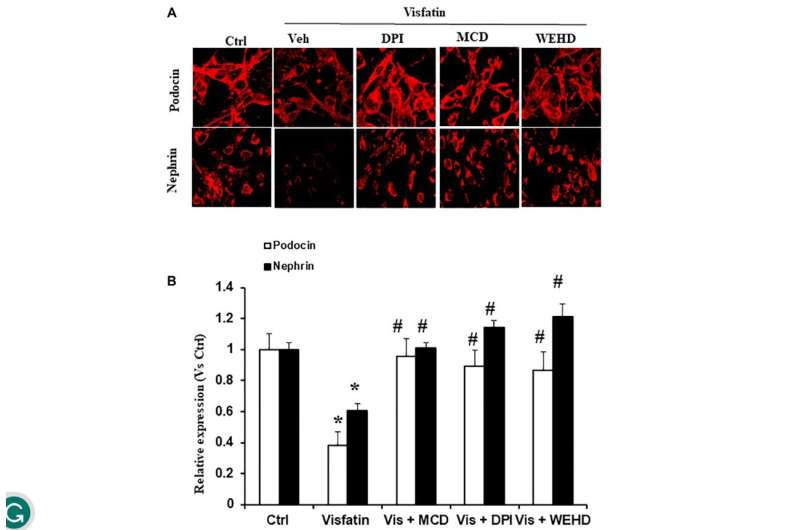This article has been reviewed according to Science X's editorial process and policies. Editors have highlighted the following attributes while ensuring the content's credibility:
fact-checked
proofread
Membrane raft redox signaling contributes to visfatin-induced inflammation and kidney damage: Study

A new research paper was published in Aging, titled, "Contribution of membrane raft redox signaling to visfatin-induced inflammasome activation and podocyte injury."
The number of obese patients with end-stage renal disease has increased significantly worldwide in the last few decades. Obesity results in an increased risk for chronic kidney diseases like diabetes and hypertension, which consequently result in chronic kidney disease or even end-stage renal disease. However, the exact mechanism of how obesity increases the advancement of chronic kidney disease is still uncertain.
Recently, researchers Saisudha Koka, Sreenidhi Surineni, Gurinder Bir Singh, and Krishna M. Boini from the University of Houston, Texas A&M University and the University of California Riverside have shown that adipokine visfatin-induced NLRP3 inflammasome activation contributes to podocyte injury.
However, the molecular mechanisms of how visfatin induces the Nlrp3 inflammasome activation and podocyte damage are still unknown. The present study tested whether the membrane raft (MR) redox signaling pathway plays a central role in visfatin-induced NLRP3 inflammasome formation and activation in podocytes.
"In this study, it is proposed that visfatin induces the NLRP3 inflammasome activation in podocytes, leading to glomerular inflammatory injury in the kidney and the development of CKD, may be primarily driven by NADPH oxidase-mediated membrane raft redox signaling," the authors write.
Upon visfatin stimulation, an aggregation of NADPH oxidase subunits, gp91phox and p47phox, was observed in the MR clusters, forming an MR redox signaling platform in podocytes. The formation of this signaling platform was blocked by prior treatment with MR disruptor MCD or NADPH oxidase inhibitor DPI. In addition, visfatin stimulation significantly increased the colocalization of Nlrp3 with Asc or Nlrp3 with caspase-1, IL-β production, cell permeability in podocytes compared to control cells.
Pretreatment with MCD, DPI, and WEHD significantly abolished the visfatin-induced colocalization of NLRP3 with Asc or NLRP3 with caspase-1, IL-1β production, and cell permeability in podocytes. Furthermore, Immunofluorescence analysis demonstrated that visfatin treatment significantly decreased the podocin and nephrin expression (podocyte damage), and prior treatments with DPI, WEHD, and MCD attenuated this visfatin-induced podocin and nephrin reduction.
In conclusion, their results suggest that visfatin stimulates membrane raft clustering in the membrane of podocytes to form redox signaling platforms by aggregation and activation of NADPH oxidase subunits enhancing O2·− production, leading to NLRP3 inflammasome activation in podocytes and ultimate podocyte injury.
"Through experiments conducted on cultured podocytes, we have demonstrated, for the first time that membrane raft-associated redox signaling is essential for the NLRP3 inflammasomes assembly and activation in response to visfatin, subsequently resulting in podocyte dysfunction and injury. These findings shed light on a novel mechanism underlying inflammasome activation and injury of podocytes triggered by visfatin," the researchers conclude.
More information: Saisudha Koka et al, Contribution of membrane raft redox signalling to visfatin-induced inflammasome activation and podocyte injury, Aging (2023). DOI: 10.18632/aging.205243




















